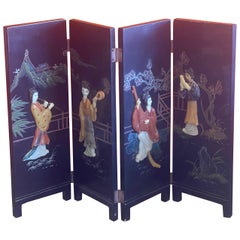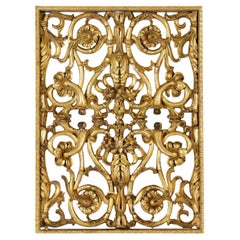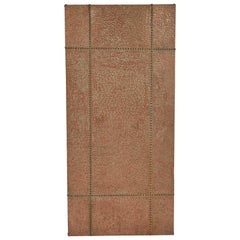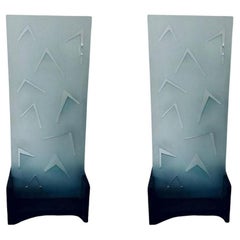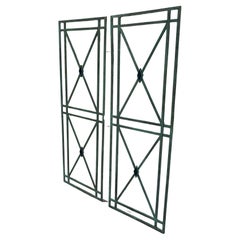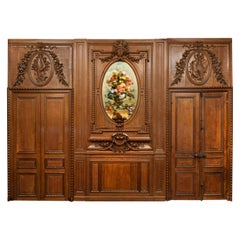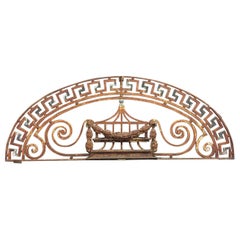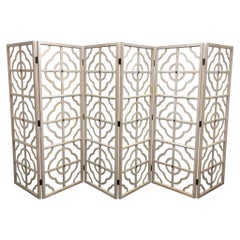South Coast - Panelling
to
1
180
104
6
Height
to
Width
to
1
1
1
1
5
1
3
1
1
2
3
3
1
1
1
5
2
2
2
1
6
6
6
Item Ships From: South Coast
Miniature Four Panel Asian Figurine Folding Screen
Located in San Diego, CA
A very nice miniature four panel Asian figurine folding screen with intricate design in wood, circa 1970s. The screen is in good vintage condition and measures 14" W x 4" D x 12" H. ...
Category
Mid-20th Century American South Coast - Panelling
Materials
Wood, Plastic
$260 Sale Price
20% Off
Mid Century French Copper and Brass Panel
Located in Los Angeles, CA
This striking mid-century French copper panel exhibits a masterful execution of Art Deco inspiration intertwined with the Arts and Crafts movement. Its richly textured and toned copp...
Category
1940s English Arts and Crafts Vintage South Coast - Panelling
Materials
Metal
Italian Giltwood Overdoor Ornament Panel, circa 1740
Located in Los Angeles, CA
Rectangular panel with elaborate foliate scrolls.
Category
18th Century Italian Baroque Antique South Coast - Panelling
Materials
Walnut
Metal and Rattan Screen or Room Divider from England
Located in Los Angeles, CA
This screen from England skillfully combines a metal frame designed to mimic bamboo with intricately woven rattan panels. The unique blend of materials and design creates an airy and...
Category
Early 1900s English Edwardian Antique South Coast - Panelling
Materials
Metal
Mid Century French Copper and Brass Panel
Located in Los Angeles, CA
This mid-century French panel, crafted with copper and brass rivets, presents a uniquely textured surface that captivates the eye. The panel's rich texture, reminiscent of intricate ...
Category
1940s French Art Deco Vintage South Coast - Panelling
Materials
Metal
1980s Italian Handmade Contemporary Room Dividers, a Pair
Located in Pasadena, CA
Pair of Italian Hand Made Contemporary Room Dividers with protruding glass. There is a white transparency to the glass. The protruding glass is a part of the esthetic glass look.
...
Category
Late 20th Century Italian Adirondack South Coast - Panelling
Materials
Art Glass, Wood
Related Items
French Directoire Style Bronze Wall Panels
Located in Sherborne, GB
French Directoire style bronze wall mounted panels, the classic X-frame panels with central diamond made from molten enamel.
So stylish, these panels can be wall mounted to give ...
Category
Late 20th Century French Directoire South Coast - Panelling
Materials
Bronze
Antique 19th Century French Chateau Oak Paneled Salon Room "Boiserie" circa 1865
Located in New Orleans, LA
A complete boiseries from the French country estate: "Chateau de Quatres Barbes." The antique 19th century French Louis XVI style grand oak paneled salon room...
Category
Late 19th Century French Louis XVI Antique South Coast - Panelling
Materials
Marble
$500,000
H 144 in W 228 in D 199 in
Matte White Brutalist Sculptural Collage Artwork, Mural from Upcycled Wood
By Peter Glassford
Located in San Antonio, TX
These MATTE WHITE collage tiles are composed randomly from recycled wood remnants and when installed bathe any space with a warm feeling and texture which...
Category
2010s Mexican Brutalist South Coast - Panelling
Materials
Wood
$74 / item
H 23.5 in W 23.5 in D 2 in
Folding Screen Room Divider in the Style of Clar Porset
By Clara Porset
Located in Mexico City, CDMX
Circa 1950, we offer this fantastic folding screen room divider in the style of Clara Porset, made in mahogany wood and palm cords, fantastic vintage conditions.
Category
1950s Mexican Mid-Century Modern Vintage South Coast - Panelling
Materials
Pine
Large Painted Louis XVI Chateau Boiserie Overdoor, Circa 1760
Located in Dallas, TX
This large painted overdoor was once part of a boiserie in a French chateau, and the upward curve of the bottom edge indicates that it was most likely placed above an arched door. Th...
Category
Mid-18th Century French Louis XVI Antique South Coast - Panelling
Materials
Wood, Paint
Chinese Rosewood and Brass Door Panel
Located in Queens, NY
Asian Chinese style (19th Century) rosewood and brass inlaid framed rounded top door panel with carved and gilt trimmed Samuri figure.
Category
19th Century Chinese Export Antique South Coast - Panelling
Materials
Brass
Set of Italian Black Lacquer and Brass Panels
Located in Dallas, TX
Amazing set of 6 black lacquer and brass panels. Great for a modern look! A true work of art. Stunning!
162 x 162
Category
Mid-20th Century Italian South Coast - Panelling
Materials
Brass
George Trollope & Sons fireplace & room, Paris Exhibition 1878 Gold Medal Winner
Located in London, GB
George Trollope and Sons. Exhibited at the Paris Universal Exhibition in 1878 winning a Gold Medal for Excellence.
The set forms the four sides of a complete panelled room that was exhibited as a boudoir room or petit salon at the Paris Exhibition 1878 .
The main feature and centrepiece of this boudoir room is the Rosso Antico marble fireplace surmounted by an open display niche carved in cedar wood.
Each side of the room is composed of various panels and are as follows:
One side with a grand Rosso Antico marble fireplace flanked by two doorways.
One side with French doors originally opening onto a balcony, flanked by two large bookshelves.
One side with a window flanked by two mirrors. The opposite side with three large mirrors.
The complete room measures:
21 ft / 6.4 m wide, 17 ft / 5.18 m deep, and 12 ft / 3.65 m high.
It could also be used in a number of different combinations to suit various room layouts. The mirrors could be replaced with windows or further bookcases.
Each side is decorated with various sizes of finely carved panels and holds ornate Corinthian style columns surmounted with cherubim's on the capitals. Three cherubs are formed at the top of each corner with three columns, at the column bases there are circular carved pedestals to display statues.
Published & illustrated in the ‘Illustrated Catalogue of the Paris International Exhibition’.
The main part of this room, the Rosso Antico marble fireplace is surmounted by a large open display niche carved in cedar wood are illustrated with a line drawing in the Paris Universal Exhibition catalogue on page 209. The whereabouts of the seminaked caryatids and the marble bust of Alexander Pope are unknown. The bust of Alexander Pope was copied from the original one in Westminster Abbey, London.
The Corinthian columns now flanking the niche above the fireplace are also in cedar wood having the identical carved fluting to the rest of the room and were made to replace the caryatid figures. Those Corinthian columns are period to the room and can only have been made shortly after it arrived back to London and before it was reassembled and fitted into the house built by George Trollope and Sons in the 1880's, and where we removed it all from.
George Trollope made clever use of Alexander Pope's early 18th-century poetical successes in Great Britain and France by using ‘The Rape of Lock’, a mock-heroic narrative poem Pope wrote in 1712 about Petre who cut off a lock of Arabella’s hair without her permission, as the theme of the boudoir room or petit salon at the 1878 Paris Exhibition.
In the original exhibition display of the room set, tapestries depicting the Rape of Lock were hung where the mirrors are now positioned.
Alexander Pope's The Rape of the Lock is a humorous indictment of the vanities and idleness of 18th-century high society. Basing his poem on an actual incident among two families of his acquaintance, Pope intended his verses to quench hot tempers and to encourage his friends to laugh at their own foolishness.
The poem is an outstanding example in the English language of the genre of mock-epic. The 'epic' was considered one of the most serious of literary forms; it had been applied, in the classical period, to the trivialities of love and war. Pope’s mock-epic is not to mock the form itself, but to mock his society in its very failure to rise to epic standards, exposing its pettiness by casting it against the grandeur of the traditional epic subjects and the bravery and fortitude of epic heroes: Pope’s mock-heroic treatment in The Rape of the Lock underlines the ridiculousness of a society in which values have lost all proportion, and the trivial is handled with the gravity and solemnity that ought to be accorded to truly important issues. The 18th-century society in this poem fails to distinguish between things that are important and things that are not. The poem mocks the men it portrays by representing them as unworthy of a heroic culture. Therefore the mock-epic follows the epic in that its main concerns are serious and moral. The point that the theme must now be satirical rather than earnest is symptomatic of how far the culture has fallen.
Retaining the original exhibition label
The back of the panelling still retains two original labels printed with the 'Union Jack' and printed adjacent to it, 'The Secretary Royal British Commission for the Universal Exhibition 1878 Champ de Mars Paris'.
Adjacent to that and below, printed and written in ink vertically:
Exhibitor: (and signed in ink) George Trollope & Sons.
Address: (written in ink) Halkin Street West. London.
Allotment in Block: (written in ink) a2. In the printed floor plan 'a2 square' is in the very first line to the right of the floor plan and handwritten in ink with a 'diamond shape' also written with '101' within it. This pin points where George Trollope's stand was located.
With thousands of items being displayed at the Exhibition, this label would have been the floor plan for the craftsmen, so they knew the correct place to install the boudoir room or petit salon.
The firm continued expanding house building and interior decoration side of the business and by 1849 was also trading as an estate agency, letting and controlling property for the Grosvenor Estates. A separate branch of cabinet-makers, bearing the family name, was opened at West Halkin Street, London. becoming known as 'The Museum of Decorative Arts' (looked after by George Robinson). Here Trollope and Sons also sold high-class antique furniture made by other makers. In 1851, the firm became formally known as George Trollope and Sons. West Halkin Street, London. The address was recorded in the listing for the firm in The Furniture Gazette Directory, 1876 & 1877.
Period Press Coverage & Art Critic Review.
everal newspapers also thoroughly describe George Trollope and Son's stand including the different tapestries that were hung where the mirrors are now, illustrating the poem 'The Rape of Lock', by Alexander Pope.
Marius Vachon, a French Art Critic and journalist, who wrote for the journal ‘La France’ published an extensive review of the Trollope and Sons stand in a book called Les Merveilles de l'Exposition de 1878 (The Wonders of the 1878 Exhibition).
Note: In the World Fairs translation it states door frame, Marius Vachon had originally written ‘chambranle’ in French, 'chambranle' loosely translates to a frame around something, and should read in its correct context: ‘fireplace in rosso antico’.
We have taken the extract below written by Marius Vachon in its translated form from: Les Merveilles de l'Exposition de 1878, (The Wonders of the 1878 Exhibition). This puts into perspective the importance of this fine quality room interior when he viewed it at the exhibition in 1878:
Marius Vachon: English furniture is very curious to observe; irreproachable from the point of view of execution, the furniture of our neighbours always reaches the last degree of respectability and comfort. One thing to be noticed is that for large pieces of furniture, the English upholsterer is transformed into a sort of architect; everything he makes takes on a monumental aspect.
The first object that catches the eye when one enters the furniture class is the beautiful boudoir-salon exhibited by Mr. Trollope. The boudoir (or petit salon), of carved cedar wood, is an attempt to reproduce the style which prevailed in England during the first decade of Queen Anne's reign, and all the details have been studied, but not copied, from examples of decorative work of the time. The fireplace is in "rosso antico" movement, and the ceiling is in portable plaster. The panels painted on canvas represent scenes from the heroic-comic poem "The Abduction of the Hairpin," (The Rape of Lock) written by Alexander Pope in 1712, the eighth year of Queen Anne's reign, in which the customs and mores of the time are satirized in a pleasing manner.
The apotheosis of the Loop and its sidereal transformations will form the decoration of the ceiling. In these illustrations of Pope's charming poem, the costumes and accessories have been taken from models of the time; and the bust of the poet, copied from his tomb in Westminster Abbey, occupies the niche in the centre of the mantelpiece.
M. Marius Vachon, the period writer of the above continues with:
Now we shall mention at random the magnificent dining table of Messrs. Johnston and Co., their oak mantelpiece, their boudoir table; Mr. Watt's drawing-room mantelpiece stepped in the old style and imitating the Japanese; Mr. James Shoolbred's great
The Decorative Arts Society on Trollope and Sons
The boudoir or petit salon is mentioned again in the Decorative Arts Society:
Trollope did not exhibit such highly rated objects at the 1878 Paris Exhibition as at previous exhibitions; items included a large mirror frame carved in limewood in Renaissance style and a satinwood cabinet in Adam revival style, with a similar armchair (illus. Meyer (2006), p. 242) and probably two rooms; one was a boudoir in cedar wood in Queen Anne style and the other was a boudoir decorated by the firm in the theme of Pope’s The Rape of Lock.
In the above extract, it is quite clear that the two rooms mentioned are in fact the very same room, because the fireplace and niche are illustrated in The Paris Universal Exhibition catalogue on page 209 and Marius Vachon describes the rest of the room set in the above…
Trollope and Sons exhibition pieces listed and described by Meyer in an article he wrote for: The Decorative Arts Society 1850 to present, Journal 25 in 2001., where he points out the importance of George Trollope and Sons and mentions a table by Trollope exhibited at the 1867 exhibition that sold for £40,000 in 1996. He also mentions a cabinet exhibited by Trollope at the International Exhibition of 1862 that sold at Sotheby's in 1997 for £150,000.
Interest was not as strong in the 1990's as it is today for rare exhibition pieces, high quality items were abundant back then, it was a golden era when the most beautiful works of art just kept coming onto the market. But there are exceptions as in this instance, when a unique, gold medal-winning exhibition work of art comes onto the market for the very first time.
Meyer continued researching and writing about the great exhibitions and released his book in 2006, 'The Great Exhibitions, London, New York, Paris and Philadelphia 1851- 1900, where he mentions only in passing, The Boudoir Room or Petite Salon exhibited by Trollope, he even states that an image was not reproduced and that Trollope's exhibits in 1878 were not up to the quality and class of the items Trollope exhibited in London in 1862 and Paris in 1868. This is probably because Meyer didn't know of the line drawing illustrating the Roso Antico Fireplace, Niche and Panelling reproduced in The Illustrated Catalogue of the Paris International Exhibition 1878 shown in the above which Geering recently uncovered.
John Meyer continues in the DAS journal:
Undoubtedly they (Trollope) are a firm worthy of further research as they were right at the forefront of the furniture business in London from 1860 to 1880.
Our research shows that the Petite Boudoir was awarded the gold medal for excellence in 1878 (see Journal La Liberté 23-10-1878 with the list of all medals attributed), something George Trollope and Sons did not achieve at the London 1862 and the Paris 1867 exhibitions. Jonathan Meyer joined Bonham's in 1977. He was Director at Sotheby's in charge of 19th Century Furniture from 1994 to June 2007. He was also chairman of the Fine Arts Faculty for The Royal Institute of Chartered Surveyors.
In the original description from the article in Les Merveilles de l’exposition de 1878, M. Marius Vachon states:
The first object that catches the eye when one enters the (English) furniture class is the beautiful boudoir-salon exhibited by Mr. Trollope.
Suggesting, it was in his opinion the very best on display in the English section, and being awarded the gold medal for excellence can only add weight to this.
Adjacent to the original label that was printed by The Secretary - Royal British Commission for the Universal Exhibition 1878 in stencil ‘TO BE KEPT’, i.e. ‘to be returned’. This confirms why it came back to London. We removed the Boudoir Room or Petite Salon from a Trollope house, part of a grand high-class housing estate in London which around the time of the exhibition Trollope and Sons were in the process of building, and where the room set was installed directly after it returned from the exhibition in 1878 until now.
Worthy of note is the machines that did the carving for the Boudoir Room or Petite Salon and also did all of the decorative carving (most of which was linenfold carving) for the Houses of Parliament, London.
This machine, the engraving and description of which we copy from Engineering, was specially designed by its inventor, Mr. Jordan, for assisting in the production of the vast amount of carved decorations required for the walls and ceilings of the Houses of Parliament, London, and it was so employed during the entire progress of the work. The late Sir Charles Barry was so well satisfied with it, that he frequently declared it would have been impossible to have accomplished the work without it. The Department of Woods and Forests employed five of the machines at the Government Works, Thames Bank, for several years; and the machines have now passed into the hands of Messrs. George Trollope and Son, and are still used in the same building.
They also exhibited the new technique of xylatechnography and sgraffito, methods of impressing coloured design into soft wood and engraving veneer to reveal the base wood.
The newspaper, La Liberte October, 23rd 1878 listing the medal winners of the Paris 1878 exhibition. Third column, ''GROUPE III MOBILIER ET ACCESSOIRES'', (GROUP III FURNITURE AND ACCESSORIES). Medailles d'or. (Gold Medals) where G Trollope et fils (G Trollope and Sons...
Category
1870s Antique South Coast - Panelling
Materials
Marble
$5,715,337
H 203.94 in W 251.97 in D 143.7 in
Chinoiserie Folding Screen or Room Divider
Located in Grand Rapids, MI
China, 1940s-1960s
Folding screen or room divider in black lacquer with hand painted decoration. Chic and functional chinoiserie piece. Each side of the screen has a different design...
Category
Mid-20th Century Chinese South Coast - Panelling
Materials
Wood, Lacquer, Paint
Folding Screen Room Divider in Solid Mahogany
Located in Mexico City, CDMX
We offer this folding screen made in solid frames of mahogany wood with brass details, circa 1950.
Category
1950s Mexican Mid-Century Modern Vintage South Coast - Panelling
Materials
Mahogany
Wicker Screen Room Divider
Located in New York, NY
A blonde/light tan wicker four (4) screen room divider with brass hardware. Very good condition as shown in images and video. Dimensions: Full Width 70.63", Height 71.63", Depth 1". ...
Category
Early 2000s South Coast - Panelling
Materials
Brass
Original Paint 18th Century French Panel
Located in Chicago, IL
Original hand-carved 18th century French original paint panel just removed from a French chateau. A warm complimentary bluish putty gray finish highlights this fine architectural fra...
Category
18th Century and Earlier French Antique South Coast - Panelling
Materials
Wood, Paint
Previously Available Items
Iron Architectural Over Door Panel
Located in Cypress, CA
Fine Italian hand forged wrought iron architectural over door panel,early 20th century. rusty finish.
Meticulous attention has been given to e...
Category
Early 20th Century Italian Neoclassical South Coast - Panelling
Materials
Wrought Iron
White Washed Oak and Aged Brass Six Panel Folding Screen by Steve Chase
By Steve Chase
Located in Palm Springs, CA
Glamorous 1990’s six panel folding screen by Steve Chase.
Out of a Steve Chase design estate in Rancho Mirage CA.
Constructed of solid white washed o...
Category
1990s American Modern South Coast - Panelling
Materials
Brass
Miniature Six Panel Folding Screen with Circular Design
Located in San Diego, CA
A very cool miniature six panel folding screen with intricate circular design in wood, circa 1970s. Each individual panel measures 5" wide x 1...
Category
Mid-20th Century American South Coast - Panelling
Materials
Wood
Large Antique Chinese Carved Panel
Located in Pomona, CA
A Chinese heavily carved panel in Chinese red finish. Panels carved with urns and vases, birds and some with floral designs. One inch thick gilt carvings on smaller chamfered panels.
Category
Late 19th Century Chinese Antique South Coast - Panelling
Materials
Wood
Pair of Chinese Carved and Painted Panels
Located in Pomona, CA
A pair of late 19th century Chinese panels in a red and black ground. Panels hand painted design over faded gold.
Category
1890s Chinese Antique South Coast - Panelling
Materials
Wood
Chinese Carved Screen with Porcelain Plaques
Located in Cypress, CA
Fine Chinese carved screen with porcelain plaques. The beautiful wood is finely carved with foliage and scroll motif fretwork centered by various...
Category
20th Century Chinese South Coast - Panelling
Materials
Porcelain, Wood
Evelyn Ackerman for Panelcarve Redwood Panels
By Evelyn Ackerman
Located in Palm Springs, CA
Hand-carved redwood decorative panels designed by Evelyn Ackerman for Panelcarve. The following is taken from the Ackerman Modern website:
Evelyn cr...
Category
1960s American Mid-Century Modern Vintage South Coast - Panelling
Materials
Wood
18th Century Louis XVI Giltwood Carved Panel
Located in Palm Springs, CA
A wonderful 18th Century carved overdoor panel depicting crossed torches with birds and swags. Gilded carvings on lovely French Gray/green panel.
arch...
Category
18th Century French Louis XVI Antique South Coast - Panelling
Materials
Giltwood, Wood
Danish Modern Tall Folding Screen in Mahogany and Capiz Shell Inserts
Located in San Diego, CA
Rare tall room divider or folding screen in solid mahogany with capiz shell inserts, circa 1950s, four panels each panel its 18 1/4" wide by 84" tall, extended its 73" wide, the cond...
Category
20th Century American Hollywood Regency South Coast - Panelling
Aluminum Sun Blockers/Panels
Located in Palm Springs, CA
Aluminum gates/panels which have been sand blasted and powder coated. These are from Kansas City, Mo. and were most likely sun blockers/shades on windows. W...
Category
1960s American Vintage South Coast - Panelling
Materials
Aluminum
Set of 3 Carved Redwood Panels by Evelyn Ackerman for Panelcarve
By Evelyn Ackerman, Panelcarve
Located in Palm Springs, CA
Set of three carved redwood panels, each comprising three 9" wide carved planks designed by Evelyn Ackerman for Panelcarve. These were originally part of a set of entry doors and have been repurposed as decorative wall panels. Each plank has "panelcarve" stamped on the back and they have been authenticated by Jerry Ackerman...
Category
1960s American Vintage South Coast - Panelling
set of 8 handpainted Chinoiserie wallpaper panels
Located in Palm Springs, CA
Creator: Gracie
Period/Style: Chinoiserie
Country: China
Date: 1960's
A Beautiful set of 8 mounted handpainted Chinese panels, probably by Gracie...
Period/Style: Chinoiserie
Country: China
Date: 1960's
A Beautiful set of 8 mounted handpainted Chinese panels, probably by Gracie...
Category
1970s Chinese Vintage South Coast - Panelling
Recently Viewed
View AllMore Ways To Browse
Vaso In Marmo
Vellum Mirror
Venini Bolle
Venini Egg
Venini Fish
Venini Glass Egg
Victorian Wash Bowl
Vintage Barbell
Vintage Black Woman Figurine
Vintage Bone China Flowers
Vintage Bourbon Glasses
Vintage Brandt End Table
Vintage Bull Figurine
Vintage Cast Iron Fire Basket
Vintage Ceramic Pig
Vintage Coffee Carafe Glass
Vintage Cowboy Saddle
Vintage Dragon Figurine
